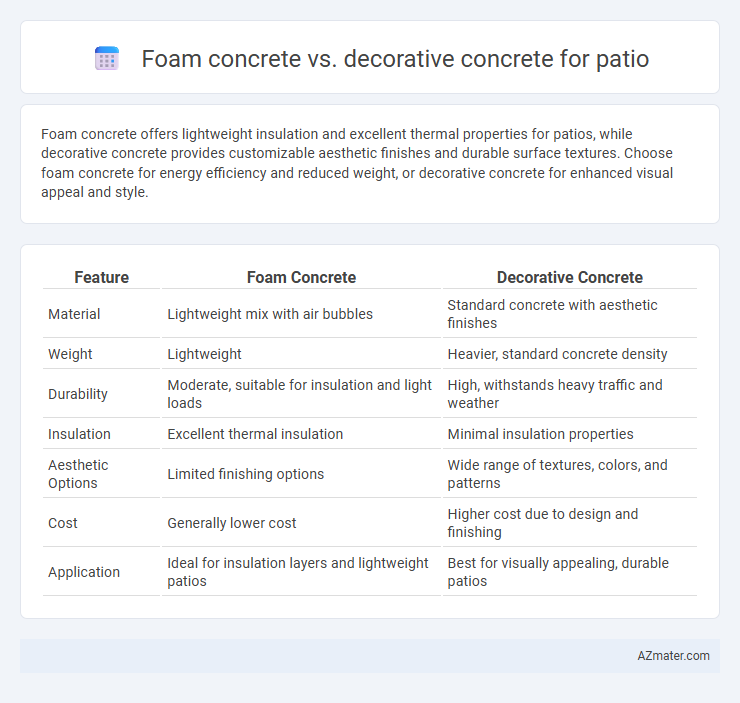Foam concrete offers lightweight insulation and excellent thermal properties for patios, while decorative concrete provides customizable aesthetic finishes and durable surface textures. Choose foam concrete for energy efficiency and reduced weight, or decorative concrete for enhanced visual appeal and style.
Table of Comparison
| Feature | Foam Concrete | Decorative Concrete |
|---|---|---|
| Material | Lightweight mix with air bubbles | Standard concrete with aesthetic finishes |
| Weight | Lightweight | Heavier, standard concrete density |
| Durability | Moderate, suitable for insulation and light loads | High, withstands heavy traffic and weather |
| Insulation | Excellent thermal insulation | Minimal insulation properties |
| Aesthetic Options | Limited finishing options | Wide range of textures, colors, and patterns |
| Cost | Generally lower cost | Higher cost due to design and finishing |
| Application | Ideal for insulation layers and lightweight patios | Best for visually appealing, durable patios |
Introduction to Foam Concrete and Decorative Concrete
Foam concrete is a lightweight, aerated material known for its excellent insulation properties and ease of application, making it ideal for patio bases and subfloors. Decorative concrete, on the other hand, emphasizes aesthetic appeal with techniques like stamping, coloring, and staining to create visually striking patio surfaces. Both materials offer unique benefits, with foam concrete suited for structural support and thermal efficiency, while decorative concrete enhances the patio's design and curb appeal.
Key Differences Between Foam Concrete and Decorative Concrete
Foam concrete is a lightweight, aerated material known for its excellent thermal insulation and soundproofing properties, often used as a base layer or for filling voids in patio construction. Decorative concrete emphasizes aesthetics through techniques like stamping, staining, or polishing, providing visually appealing, customizable surfaces with durable finishes for patios. Foam concrete prioritizes functionality and insulation, while decorative concrete focuses on enhancing patio appearance and design.
Composition and Material Properties
Foam concrete consists primarily of cement, water, and a foaming agent creating a lightweight, porous structure with excellent thermal insulation and low density, ideal for sub-base applications in patios. Decorative concrete combines cement, aggregates, pigments, and surface treatments such as stamping or staining to achieve aesthetic appeal alongside structural strength, offering durability and customizable finishes for patio surfaces. The key difference lies in foam concrete's lightweight and insulating properties versus decorative concrete's robust, visually versatile composition tailored for exposed surface durability.
Installation Processes Compared
Foam concrete for patios involves mixing cement, water, and foam to create a lightweight, insulating material applied in thick layers for efficient leveling and quick drying. Decorative concrete installation requires precise surface preparation, stamping or staining, and sealing to achieve aesthetic patterns and textures, demanding more skilled labor and longer curing times. Foam concrete offers faster installation and superior thermal properties, while decorative concrete emphasizes visual appeal through intricate finishing techniques.
Durability and Longevity
Foam concrete offers excellent durability due to its lightweight and cellular structure, making it highly resistant to cracking and freeze-thaw cycles, which enhances patio longevity. Decorative concrete, while visually appealing with various finishes and textures, relies on proper sealing and maintenance to prevent surface wear and degradation over time. For long-lasting patios, foam concrete provides superior structural resilience, whereas decorative concrete excels in aesthetic customization but may require more upkeep to maintain durability.
Aesthetic Options and Customization
Foam concrete offers limited aesthetic options due to its uniform texture and pastel color palette, making it ideal for basic patio bases but less suited for decorative finishes. Decorative concrete excels in customization, allowing for stamped patterns, stains, dyes, and exposed aggregates to create intricate designs and vibrant colors tailored to specific patio styles. Homeowners seeking unique visual appeal and detailed personalization typically prefer decorative concrete for enhancing outdoor living spaces.
Cost Analysis: Foam vs Decorative Concrete
Foam concrete offers a lightweight, cost-effective solution for patios, typically reducing material and labor costs by up to 30% compared to decorative concrete. Decorative concrete involves higher expenses due to intricate finishes, stains, and stamping techniques, often increasing project costs by 20-50%. Maintenance costs for decorative concrete tend to be higher over time, while foam concrete requires less frequent upkeep, contributing to overall savings.
Maintenance and Upkeep Requirements
Foam concrete requires minimal maintenance due to its lightweight and porous structure, resisting cracking and shifting under weather fluctuations. Decorative concrete demands regular sealing and occasional cleaning to preserve its aesthetic patterns and prevent surface wear from exposure to UV rays and foot traffic. Both materials benefit from routine inspections to address minor repairs promptly and extend patio longevity.
Environmental Impact and Sustainability
Foam concrete significantly reduces environmental impact through lower cement content and improved thermal insulation, enhancing energy efficiency in patio construction. Decorative concrete often relies on traditional mixes with higher carbon footprints but can incorporate recycled aggregates and low-VOC stains to improve sustainability. Choosing foam concrete optimizes resource use and minimizes waste, while decorative concrete offers versatile aesthetics with potential eco-friendly adaptations.
Choosing the Right Concrete Type for Your Patio
Foam concrete offers lightweight insulation and excellent thermal properties, making it ideal for patios requiring enhanced energy efficiency and reduced load on foundations. Decorative concrete excels in durability and aesthetic versatility, allowing for customizable patterns, colors, and textures that enhance curb appeal. Selecting between foam and decorative concrete depends on prioritizing insulation and weight savings versus design flexibility and surface durability for your patio project.

Infographic: Foam concrete vs Decorative concrete for Patio
 azmater.com
azmater.com